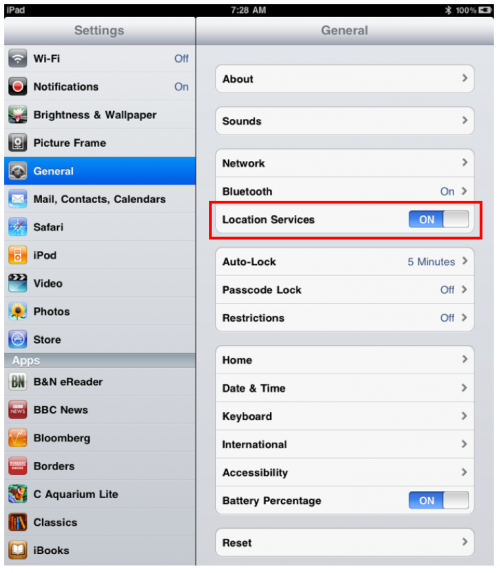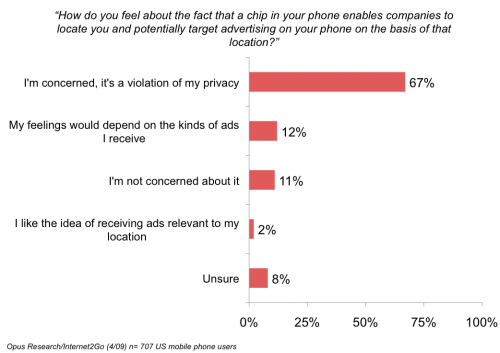Privacy, Location Sharing & Opting-Out On Apple iDevices
On Monday when Apple released its iOS 4 software update it changed its terms and privacy policy. One of the provisions of the new privacy terms — though few typically read them — concerns location monitoring and sharing in the background. Here’s what it now says about location: To provide location-based services on Apple products, […]
On Monday when Apple released its iOS 4 software update it changed its terms and privacy policy. One of the provisions of the new privacy terms — though few typically read them — concerns location monitoring and sharing in the background.
Here’s what it now says about location:
To provide location-based services on Apple products, Apple and our partners and licensees may collect, use, and share precise location data, including the real-time geographic location of your Apple computer or device. This location data is collected anonymously in a form that does not personally identify you and is used by Apple and our partners and licensees to provide and improve location-based products and services. For example, we may share geographic location with application providers when you opt in to their location services.
Some location-based services offered by Apple, such as the MobileMe “Find My iPhone” feature, require your personal information for the feature to work.
Although users are able to manage location in their settings (see graphic from iPad settings) and not allow third party apps to use location, Apple is still collecting that information for its own purposes.

Apple’s location policies were presented as a bit of a scandal on Techmeme in several posts.
Compare Google’s very similar (albeit unwieldy) mobile privacy policy:
- Most of the other information we collect for mobile, such as your device and hardware IDs and device type, the request type, your carrier, your carrier user ID, the content of your request, and basic usage stats about your device and use of Google’s products and services does not by itself identify you to Google, though it may be unique or consist of or contain information that you consider personal. However, if you use an Android-powered device, Google will associate your device id with your Google Account in order to provide services, such as sync functionality for your Google email and contacts.
- If you use location-enabled products and services, such as Google Maps for mobile, you may be sending us location information. This information may reveal your actual location, such as GPS data, or it may not, such as when you submit a partial address to look at a map of the area . . .
- We may share your information with certain third parties we use to perform certain functions, such as billing and text message or SMS delivery. These third parties will be required to treat your information in accordance with the applicable Google privacy policies. We may also share some information with your wireless operator in order to perform customer service functions.
There are plenty of people upset with the basic proposition that anyone is collecting user location on mobile devices or providing content and ads based on that location. For example, The Center for Digital Democracy and the US Public Interest Research Group have complained to the FTC and requested an inquiry into what these groups characterize as “Unfair and Deceptive Mobile Marketing Practices.” Such “deceptive practices” include ad targeting by location.
According to the formal complaint (.pdf), filed in January of 2009:
Quattro Wireless, finally, has seized upon the growing “smart phone” market, mobile devices that rival laptop computers in power and flexibility, to produce “…the industry’s first true location-based iPhone ad unit courtesy of Quattro Wireless and the uLocate WHERETM application….
The iPhone represents the ultimate 1-1 marketing and advertising opportunity— the savvy advertiser gets to participate in the intimate and highly functional relationship between the consumer and their personal device…. Advertising within iPhone applications provide an additional level of functionality and innovation for the advertiser. With full integration and the ability to determine the user’s location, marketers have many new personalized and localized advertising opportunities. WHERETM’s local search functionality further extends the marketer’s opportunity to pinpoint a consumer’s location and serve up relevant messages paired to their search interests.
While consumer attitudes and behavior often contradict one another, many consumers (at least in the abstract) don’t like the idea of being monitored or targeted by location on mobile devices:
This is generally parallel to consumer attitudes about ad-targeting online. Generally consumers express concern or objections to the idea of being tracked and targeted. However, they also want and respond to more relevant ads, which is only possible in search without targeting. On mobile devices location is an important determinant of relevance.
Mobile carriers have location and other personally identifiable information about their subscribers. As a result, there’s effectively no way for consumers to completely opt-out of location monitoring. The question becomes: how to manage location and related disclosures so that consumers know when location is being used and have some measure of control over it.
Along those same lines, Apple is allowing users to opt-out of receiving iAds. The privacy policy says the following:
Apple and its partners use cookies and other technologies in mobile advertising services to control the number of times you see a given ad, deliver ads that relate to your interests, and measure the effectiveness of ad campaigns. If you do not want to receive ads with this level of relevance on your mobile device, you can opt out by accessing the following link on your device: https://oo.apple.com.
If you opt out, you will continue to receive the same number of mobile ads, but they may be less relevant because they will not be based on your interests. You may still see ads related to the content on a web page or in an application or based on other non-personal information. This opt-out applies only to Apple advertising services and does not affect interest-based advertising from other advertising networks.
You need to opt out on every Apple device. And you’re still going to receive ads, they’re just not going to be as relevant:
If you opt out, you will continue to receive the same number of mobile ads, but they may be less relevant because they will not be based on your interests.
This is parallel to a program and approach that mobile ad network JumpTap is pursuing. The company is using a personalized advertising “dashboard” to allow consumers to convey their interests to the ad network. Consumers can also opt-out of participation though that will similarly affect the relevance of ads they receive.
On the PC Google pioneered the idea of a consumer privacy/ad targeting dashboard, which has now been adopted by Yahoo as well.
Going forward the issue is not going to be whether location data is collected but by whom and what types of disclosures and consumer control are required. Europe has taken a tougher approach to data retention and user privacy than regulators in the US. Apple and Google are sure to face greater scrutiny on the other side of the Atlantic accordingly. And the discussion of mobile advertising and targeting has just begun.
Because targeting on mobile devices can be so much more precise than online (to date) it’s sure to continue to be a hot topic and subject of debate for quite some time.
Contributing authors are invited to create content for Search Engine Land and are chosen for their expertise and contribution to the search community. Our contributors work under the oversight of the editorial staff and contributions are checked for quality and relevance to our readers. The opinions they express are their own.
Related stories
